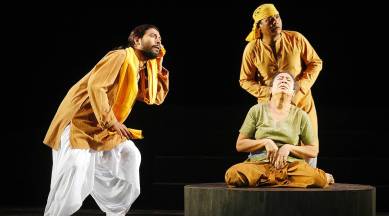The director who didn’t need words
Heisnam Kanhailal, who passed away yesterday, was a master of using the bodies and energies of actors to create powerful narratives.

ONE OF Heisnam Kanhailal’s most powerful plays was also his most controversial. Draupadi, based on a book by Mahasweta Devi, revolves around a young, tribal girl and rebel who is arrested and continuously raped by army men until, tired, defiant and helpless, she greets a rapist by tearing apart her clothes and confronting him with her brazen, naked body. Heisnam Sabitri Devi, wife of the director, stood nude before the audience radiating a shaman-like power. Feminist and other groups were deeply offended. The actor had shamed Manipuri society, especially its women, they said.
“We have performed only two shows in Manipur but several around India,” the director said in an interview with The Indian Express. Four years later, Sabitri Devi was in Delhi when she received a phone call. “A group of Imas (mothers) had stripped naked in the public before the Kangla Fort, carrying a banner that said ‘Indian Army Rape Us’. I started to cry,” she said.
monthly limit of free stories.
with an Express account.
Kanhailal, whose art, aesthetics and politics has made a great contribution to Indian theatre, passed away on October 6. He had been honoured with the Padma Bhushan and the Padma Shri, among others. “He had joined the National School of Drama (NSD) but was thrown out by the end of first year. That’s when he went back to Manipur and began to delve into the history and culture of the state. He went deep into it — not through any theory but through performance,” says theatre critic Samik Bandyopadhyay.
The presence of the body was paramount in Kanhailal’s theatre; it supplemented word, perhaps because of his own history of problems with the spoken word. As a young boy from a poor family in Manipur, he had left NSD within six months because, it is thought, he was unable to write, read and perform in Hindi and English.
Kanhailal, who had worked with Badal Sircar and was deeply influenced by him, trained his own actors at Kalakshetra Manipur, the centre he founded in 1969. “He set up Kalakshetra in an open valley, outside the city. He settled there with his family and some actors. At Kalakshetra, he was completely devoted to doing theatre. For a living, however, he used to conduct workshops in Delhi and other places. His was an extremely rich theatre, which was rooted and belonged to a community,” says Bandyopadhyay.
The acting methodology was organic and according to each actor’s individual psychophysical needs. Waman Kendre was a first-year student of the NSD, where he is now director, when he watched Pebet, a landmark play of Kanhailal. “I was shocked. There were no words in the play, yet the communication was so strong that the entire audience was crying by the end.” Kabuui-Keioiba (half-man half-tiger), another old folk story, too, used the body and kept words to a minimum. A few theatre critics say Kanhailal’s theatre is similar to Polish theatre practitioner Jerzy Grotowski’s “Poor Theatre” that dismissed elements such as props and costumes and emerged through an actor’s skills alone.
Pebet, drawn from a Manipuri folk tale about two birds and a cat, was one of the plays in which the director’s politics emerged in a lyrical, fluid and physical way rather than a didactic discourse. His repertoire was drawn from all kinds of impulses. He adapted Meithei rituals in his theatre, strongly demonstrated in his production, Dak Ghar about a young boy Amal who is dying. Memoirs of Africa was an allegory of the oppressive effects of colonisation on Manipur.
The great archetypes, such as freedom, beauty and oppression, came alive in Kanhailal’s plays, such as Nupi Lan (Women’s War of Manipur), which was performed by a hundred women from the markets of Imphal. “His passing away is one of the great tragedies of my life. He is among the greatest theatre directors India ever produced,” says Ratan Thiyam, chairman of NSD and a Manipur-based director.